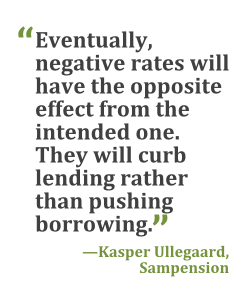When interest rates are high, people borrow less and save more. When they're low, savings go down and borrowing goes up. But what happens when rates stay negative?
In Denmark, where rates have been below zero longer than anywhere else on the planet, the private sector is saving more than it did when rates were positive (before 2012). Private investment is down and the economy is in a “ low-growth crisis,” to quote Handelsbanken. The latest inflation data show prices have stagnated.
 As the Danes head even further down their negative-rate tunnel, the experiences of the Scandinavian economy may provide a glimpse of what lies ahead for other countries choosing the lesser known side of zero.
As the Danes head even further down their negative-rate tunnel, the experiences of the Scandinavian economy may provide a glimpse of what lies ahead for other countries choosing the lesser known side of zero.
Complete your profile to continue reading and get FREE access to Treasury & Risk, part of your ALM digital membership.
Your access to unlimited Treasury & Risk content isn’t changing.
Once you are an ALM digital member, you’ll receive:
- Thought leadership on regulatory changes, economic trends, corporate success stories, and tactical solutions for treasurers, CFOs, risk managers, controllers, and other finance professionals
- Informative weekly newsletter featuring news, analysis, real-world case studies, and other critical content
- Educational webcasts, white papers, and ebooks from industry thought leaders
- Critical coverage of the employee benefits and financial advisory markets on our other ALM sites, PropertyCasualty360 and ThinkAdvisor
Already have an account? Sign In Now
*May exclude premium content© 2025 ALM Global, LLC, All Rights Reserved. Request academic re-use from www.copyright.com. All other uses, submit a request to [email protected]. For more information visit Asset & Logo Licensing.





